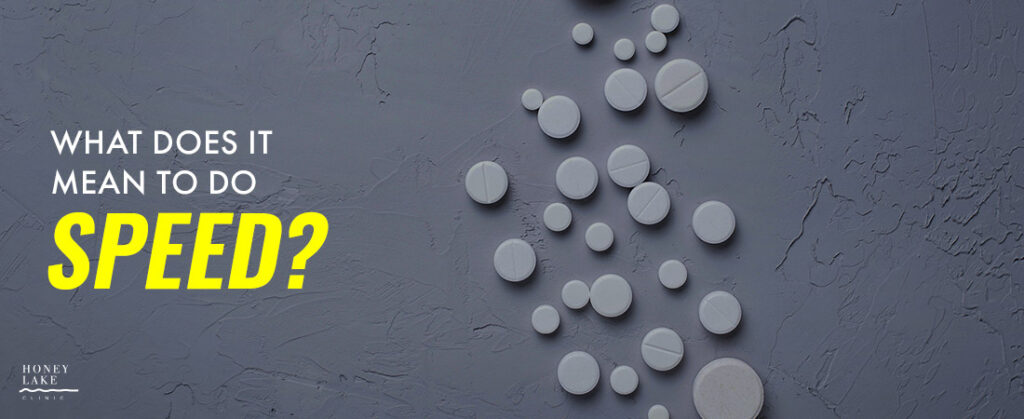What Does it Mean to do Speed?
Speed is a common street name for methamphetamine, a potent and addictive central nervous system stimulant, chemically related to amphetamine.
It is very similar to amphetamine but with more intense effect and more severe side effects.
Methamphetamine is highly addictive. As such, it is classified as a Schedule II stimulant by the U.S. Drug Enforcement Agency (DEA).
Medically, it has been used for the treatment of attention deficit hyperactivity disorder (ADHD) and obesity, but these uses are limited in the U.S. due to the high potential for abuse and addiction.
Prescription doses are typically much lower than those used illegally.
Why is it Called Speed?
Speed gets its name from the impact the stimulant typically has—an adrenaline rush that will get you up and keep you racing for hours.
Other street names for methamphetamine when it is being abused include meth, chalk, uppers, phet, whiz, sulph, base and dexy.
What Does Speed Look Like?
The appearance of speed can change depending on how it is taken. It usually comes in the form of a white or a salmon colored powder, and can sometimes look crystallized.
The base form and purer type of speed is usually pink or gray, and feels like putty.
How is Speed Used?
Speed can be snorted, smoked, injected, or taken orally.
The method of intake influences the drug’s effect—injected, the drug, the first symptoms start immediately; snorted, effects appear after a couple of minutes; swallowed, the reaction can take several minutes.
How Does Speed Work?
Speed increases the levels of dopamine in your brain, stimulating the central nervous system.
Dopamine is a neurotransmitter responsible for good moods and the sensation of happiness.
Speed’s popularity has grown amongst teens and college students because of its ability to energize the and keep them awake—to party and then study.
After initial speed use, many become addicted due to the traits of amphetamine and the other substances mixed in with it.
Short-term Effects of Doing Speed
- Exhilaration, energy and confidence
- Insomnia
- Loss of appetite
- Dilated pupils
- Increased breathing, heart rate and blood pressure levels
- Dry mouth, diarrhea and increased urination
- Flushing, sweating, headaches, teeth grinding, jaw clenching and racing heart
- You may become talkative, even argumentative and aggressive
- You may experience amphetamine psychosis
Long-term effects of Doing Speed
- Rising tolerance; the more you take, the more you’ll need to get the same high
- Anxiety, depression, irritability and aggression
- Powerful cravings
- Mood swings
- Mental health problems such as psychosis, paranoia, delusions and hallucinations
- Weight loss
- Scratching or itchy skin
- Sniffing speed can damage the inside lining of your nose
- Injecting speed can cause vein damage and sharing needles puts you at risk of HIV and hepatitis
Other dangers of Doing Speed
- Risk of overdose
- Heart failure
- Risk of HIV and hepatitis if you share snorting or injecting gear
- May trigger underlying mental health problems
- Increased sex drive can lead to unsafe sex and sexually transmitted disease
- Increased danger when combined with anti-depressants or alcohol
The damage excessive use of speed can cause is irreversible. Psychiatric symptoms can last for years, even after a person has stopped using the drug. These symptoms consist of things like psychotic episodes in which the user suffers from delusions, severe agitation or uncontrollable panic attacks.
Symptoms of Speed Abuse
Speed abuse can result in a number of dangerous physical, psychological and behavioral symptoms.
Some Physical Symptoms of Speed Abuse Include:
- Addiction
- Tolerance
- Dilated pupils
- Arrhythmia
- Fast breathing
- Nausea
- Vomiting
- Headache
- Seizures
- Skin problems
- High blood pressure
Psychological Symptoms of Speed Abuse Include:
- Paranoia
- Aggression
- Psychosis
- Hallucinations
- Euphoria
- Mood swings
Behavioral Symptoms of Speed Abuse Include:
- Insomnia
- Increased level of energy
- Loss of appetite
- Improved work performances
- Memory improvement
- Increased or decreased interest in sex
- Increased physical performance
Speed Impurity
Speed is one of the least pure drugs on the street. Dealers and suppliers tend to cut with it with other amphetamines, caffeine, sugars and other substances to increase its weight and value.
The drug sold as speed is usually only between 5-15% amphetamine sulfate powder, those unknown ingredients making it even more dangerous, increases the chance of overdose dramatically.
You cannot be sure what you’re ingesting.
Addictive
You can become addicted to speed physically and psychologically, to the extent your body craves it and you find it hard to cope with life and function without it. This makes stopping extremely difficult. Withdrawal symptoms can be very difficult and even life-threatening.
Often those recovering from methamphetamine abuse suffer anxiety and panic attacks as a part of withdrawal.
Some of the most dangerous physical withdrawal symptoms are:
- Drug cravings
- Seizures
- Insomnia
- Tremor
- Fever
- Sweating
- Nausea
- Vomiting
- High blood pressure
- High heart rate
- Respiratory failure
- Coma
- Death
Psychological withdrawal symptoms include:
- Paranoia
- Hallucinations
- Anxiety
- Depression
Does any of this look familiar? If you see signs of methamphetamine abuse or addiction in yourself or a loved one, we can help.
At Honey Lake Clinic, we understand that substance abuse is a complex and dangerous mental health concern, affecting not only the one in its grip, but also others.
Our experienced staff, licensed therapists, psychologists, and psychiatric specialists, strongly believe that faith-based treatment, encompassing mind, body and spirit, will provide you with the long-lasting tools and knowledge to find freedom from substance abuse.
A beautiful and tranquil 650-acre lakeside setting, a safe medical environment, 24-hour nursing, doctors and psychiatric specialists, all administering care from a Christian worldview and perspective—
Honey Lake Clinic is a unique solution in Christian mental health.
